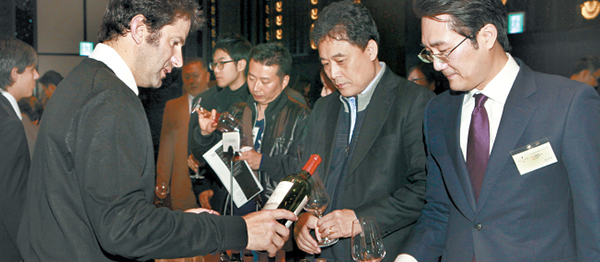Argentine wines growing on Korea
Published: 19 Nov. 2012, 20:15

Sommeliers, importers and other connoisseurs of wine swirl glasses of malbec at the 4th Wines of Argentina Festival on Nov. 8 at the Banyan Tree Club & Spa in central Seoul. By Park Sang-moon
Red-violet malbec, with its robust, fruity note, and white torrontes, aromatic and slightly tart, are flagship Argentine wines that wine connoisseurs enjoyed at a wine testing festival at a hotel in central Seoul.
Though Koreans are still relatively new to Argentine wine, more than 40 wineries from the southernmost South American country are imported here.
While cabernet sauvignon, merlot and other more common varieties were also offered by the Argentine wineries at the festival organized by the Embassy of Argentina in Seoul, sommeliers from restaurants, hotels and businesses, as well as wine importers, critics and experts sought out the malbec and torrontes on Nov. 8.
“Argentina is one of the top five wine countries in the world,” said Argentine Ambassador to Seoul Carlos Alberto Arganaraz.
“The arrival of the European immigrants in the 19th century helped develop local wineries as they brought in their techniques.”
The blend of such old skills from Europe and Argentina’s distinct terroir which contributes to mostly organic, lush vineyards, bodes well for the country’s distinct wine, said the ambassador.
Guillaume Raffy is the 31-year-old managing director of the family-owned Bodega Raffy, one of the wineries represented that day.
He is a banker turned winery owner, leaving Citibank last year when their family winery business took off.
His philosophy professor father, Frenchman Jean-Louis Raffy, purchased land in lush Mendoza, the heart of Argentine vineyards, in 2007.
Their winery is indeed a blend of France with the aromatic and powerful grapes of the vineyards of Mendoza, in central Argentina, adjacent to the Andes Mountain Range.
Malbec grapes were initially grown by the French.
“Life is short, so I decided that I must pursue my passion,” said Raffy.
They produced their first commercial bottle of wine in 2010. Raffy’s 2010 Reserve Malbec received the Decanter World Wine Award this year, among various other awards.
Though it is his first time in Korea, Raffy said, “Our malbecs go well with meat and match Korean barbecue very well.”
This year, 16 wineries in the Wines of Argentina organization were represented at the 4th annual wine tasting festival in Banyan Tree Resort & Spa Seoul.
Wines of Argentina, bringing together over 200 wineries, which account for 95 percent of the country’s wine exports, has promoted its wine brand abroad since 1993 and has especially been working on expanding its Asian market over the past several years.
Like Raffy, some wineries are small, family owned vineyards, while others have decades of history. Casa Bianchi, founded in 1928, recently launched its “Leo” line of malbec and torrontes wines.
“As homage to Argentine soccer player Leo Messi, the bottles infused football designs in the labels - we had to try to keep it classy while relevant,” said Andres Kemeny, export manager of Casa Bianchi. “A percentage of profits from the sale of the Leo wine goes to the Leo Messi Foundation, which develops children’s education programs.”
“There are more limited choices this year than last year but finer, higher quality wines are offered,” food critic and author Hugh Ahn stated, adding that “Korea is a very big emerging wine market. Argentina produces great wines but many are not imported to Korea yet.”
Wine exports to Korea have steadily grown, said Wines of Argentina Asia manager Antonio Mompo, “but it still is not enough.”
“In the south, there are desert conditions and it is very windy, hence the grapes there have very thick skins. When you produce wine from such grapes, they have more structure because the skin forms the color and flavor of the wine,” said Mompo, describing how each region’s wines and vineyards have different characteristics - the country has over 1,300 vineyards.
With its efforts, Argentina has seen world consumers of its wine grow. In 2011 the country exported wine to 126 countries, compared to 23 countries in 1993.
By Sarah Kim [sarahkim@joongang.co.kr]










with the Korea JoongAng Daily
To write comments, please log in to one of the accounts.
Standards Board Policy (0/250자)